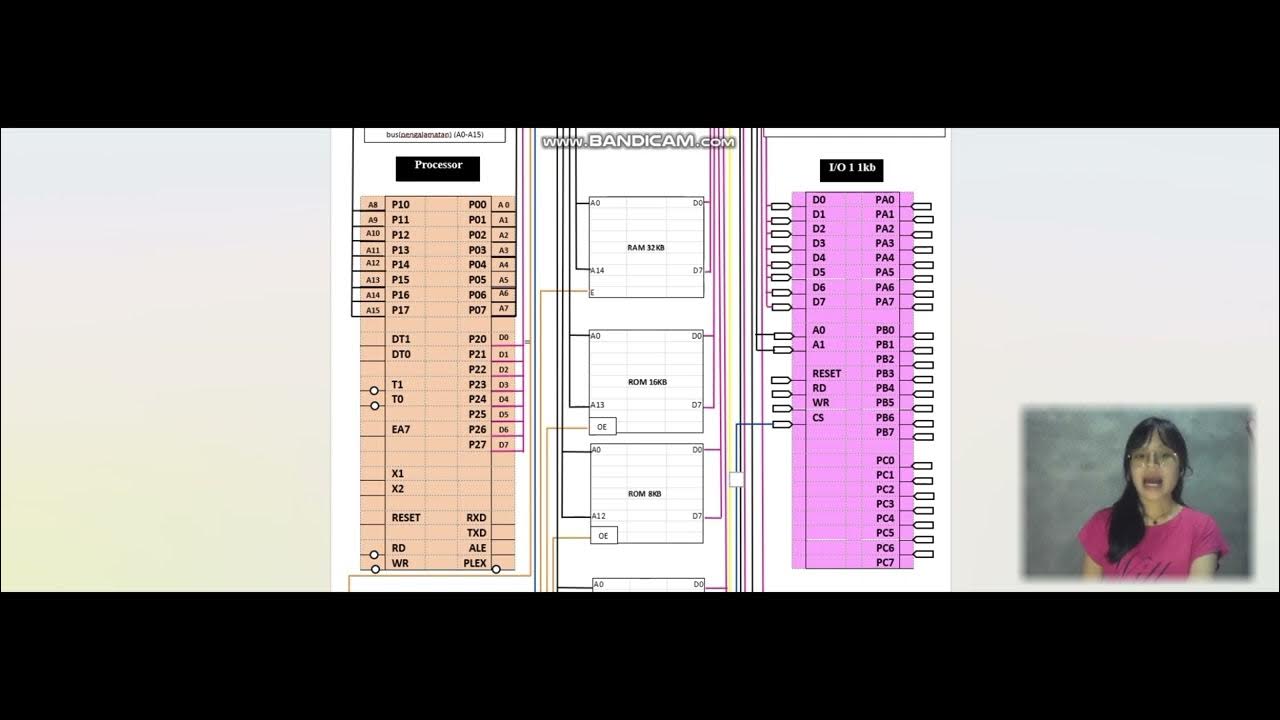Hardware Description Language Course Unit 8 (Midterms Week 8 Lesson) - Decoder Combinational Circuit
Summary
TLDRThis lecture on decoders in digital systems covers the role of decoders as combinational circuits that convert binary input into unique output values. The discussion explains how decoders work, with examples including converting binary to hexadecimal or octal and driving seven-segment displays. Key topics include the formula for determining the number of outputs (2^n), the importance of Boolean algebra in designing decoders, and practical applications in hardware. The lecture emphasizes both the theoretical understanding and practical implementation of decoders, especially in hardware description languages (HDL) and digital circuit design.
Takeaways
- 😀 Decoders are combinational logic circuits used to convert binary information into distinct outputs, with applications in digital systems.
- 😀 Discrete quantities of information, such as numbers or categorical values like 'male' or 'female,' are represented in digital systems using binary codes.
- 😀 A decoder's functionality is based on the binary code of 'n' input bits, which can represent up to 2^n distinct outputs.
- 😀 The number of outputs in a decoder is determined by raising 2 to the power of the number of input bits. For example, 3 inputs will give 8 outputs.
- 😀 Decoders can convert binary codes into other number systems, such as hexadecimal or octal, and can be used in various applications like seven-segment displays.
- 😀 A decoder circuit consists of n input lines and up to 2^n output lines, with the output representing different binary codes for various inputs.
- 😀 In practical decoder circuits, each unique combination of binary inputs corresponds to a specific output, and unused combinations are marked as 'don't care' (X).
- 😀 The key mapping and Boolean algebra simplification (through Karnaugh maps) are used in decoding circuits to reduce the complexity of the circuit.
- 😀 The decoder circuit is often implemented using NOT and AND gates, as these gates are economical for generating the necessary terms for the decoder's operation.
- 😀 Seven-segment decoders are used for displaying numerical digits in devices like clocks and calculators, where specific segments light up depending on the input binary code.
Q & A
What is a decoder in digital systems?
-A decoder is a combinational logic circuit that converts binary information from n input lines into one of 2^n distinct output lines. It is used to map a set of binary inputs to a corresponding set of unique outputs.
How does a decoder work in terms of binary input and output?
-A decoder takes an n-bit binary input and produces a maximum of 2^n unique outputs. The outputs correspond to the binary codes that represent distinct values. For example, a 3-input decoder can generate 8 distinct outputs, as 2^3 = 8.
What is the significance of the binary code in a decoder?
-The binary code is used to represent discrete quantities of information in digital systems. For instance, a binary code can represent categorical data, such as gender (male = 1, female = 0) or survey responses (e.g., Strongly Agree = 5).
Can you explain how a decoder is used with a seven-segment display?
-A decoder is used in seven-segment displays to convert a binary-coded decimal (BCD) input into the corresponding display segments. For example, a binary input of 0001 would light up specific segments on the seven-segment display to show the number 1.
How do the number of inputs affect the number of outputs in a decoder?
-The number of outputs in a decoder is determined by the number of inputs. The formula is 2^n, where n is the number of input bits. For example, with 4 input lines, a decoder would produce 16 outputs, as 2^4 = 16.
What are 'don't care' conditions in decoder outputs, and how are they handled?
-'Don't care' conditions occur when certain combinations of input values are not used in the decoder’s specification. These conditions are often represented by 'x' and can be handled in Boolean algebra using K-map simplification, where the 'x' values can be treated as either 0 or 1, depending on the context.
What is the role of Boolean algebra in decoding?
-Boolean algebra is used to simplify the logic needed to implement a decoder. It helps reduce the complexity of the decoder circuit by optimizing the number of gates required to generate the necessary outputs. K-maps are often used for Boolean simplification.
How are decoders constructed in terms of logic gates?
-Decoders can be constructed using NOT and AND gates. The NOT gates are used to invert outputs, and the AND gates generate the necessary logic to convert the binary inputs into the corresponding output lines.
What are some applications of decoders besides hexadecimal conversion?
-Besides hexadecimal conversion, decoders are widely used in applications like converting octal to binary, controlling seven-segment displays, and in digital systems requiring specific code conversions.
What is the advantage of using decoders in hardware description languages (HDL)?
-Using decoders in HDL allows for the efficient design and simulation of digital circuits. By implementing decoders with HDL, designers can model complex logic circuits more easily and test them for correctness before physical implementation.
Outlines

Cette section est réservée aux utilisateurs payants. Améliorez votre compte pour accéder à cette section.
Améliorer maintenantMindmap

Cette section est réservée aux utilisateurs payants. Améliorez votre compte pour accéder à cette section.
Améliorer maintenantKeywords

Cette section est réservée aux utilisateurs payants. Améliorez votre compte pour accéder à cette section.
Améliorer maintenantHighlights

Cette section est réservée aux utilisateurs payants. Améliorez votre compte pour accéder à cette section.
Améliorer maintenantTranscripts

Cette section est réservée aux utilisateurs payants. Améliorez votre compte pour accéder à cette section.
Améliorer maintenantVoir Plus de Vidéos Connexes

How Combinational Logic Devices Work - The Learning Circuit

Explain Decoder with Truth Table | Circuit Diagram | Logical Expression in Digital electronics

Organisasi dan Arsitektur Komputer

4- Circuitos Combinacionales - Multiplexores y Demultiplexores

Pahami Dasar Elektronika Digital

Introduction to Sequential Circuits | Important
5.0 / 5 (0 votes)
